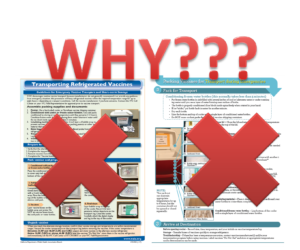 Why Are You Still Using Ice to Keep Vaccine Cool?
Why Are You Still Using Ice to Keep Vaccine Cool?
Here is a novel idea for transporting refrigerated vaccine: NEVER PUT ANYTHING BELOW 2°C IN A COOLER WITH VACCINE! (Even conditioned water/ice bottles.)I know, I know, I know…the standard practice is to use “properly conditioned” ice-packs. It is a method, but one that I want to challenge. So here it is…
We all know that refrigerated vaccines should be kept between 2° and 8°C, and for the most part keeping vaccine from becoming too warm is easy. In fact, most vaccines can tolerate a brief temperature excursion up to 37°C/98.6°F. What most vaccines cannot tolerate is a brief exposure to a temperature below 0°C. Here are some examples that are damaged or weakened when exposed to 0°C or below:
- DTaP
- DTaP-hepatitis B-Hib-IPV (hexavalent)
- DTwP
- DTwP-hepatitis B-Hib (pentavalent)
- Hepatitis A
- Hepatitis B
- Human papillomavirus
- Meningitis C (polysaccharide-protein conjugate)
- Pneumococcal (polysaccharide-protein conjugate)
- TT, DT, Td
- Cholera (inactivated)
- Influenza (inactivated, split)
- Hib (liquid)
- Inactivated poliovirus
- Typhoid polysaccharide
- Meningitis A (polysaccharide-protein conjugate)
- Rotavirus (liquid and freeze dried)
- Yellow fever
- Bacillus Calmette-Guérin
- Hib (freeze dried)
- Japanese encephalitis (live and inactivated)
- Measles
- Measles, mumps, rubella
- Oral poliovirus
- Rabies
- Rubella
- Varicella-zoster virus
Enter in coolers. Coolers are containers with insulation. These portable, relatively lightweight, vaccine carriers (that come in all kinds of shapes and sizes) transport and hold vaccine within a 2° to 8°C range when away from its refrigerated home. But not without a little help.
That’s where the coolant comes in. A source of “coolness” helps keep the coolers inside temperature from rising towards the outside ambient temperature (this is a general statement…there are times where coolant needs to prevent the temperature from dropping). The passive variety (non-electrical) comes in many shapes and sizes, but are generally a PCM coolant.
You may not know what PCM stands for, but you are familiar with it. PCM stands for “phase change material.” The most common PCM we all encounter on a daily basis is water. At 0°C/32°F, water changes from one phase to another (liquid to solid; solid to liquid). This phase change property is helpful in decreasing, increasing, or maintaining the temperature of something else. For instance water, in its frozen form known as ice, can cool down a soda. On the flip side, in its liquid form water can help protect a crop from freezing. The “magic” is the amount of energy it takes to make water move from one phase to another. The energy needed to turn water at 1°C into ice at 0°C is much greater than the amount of energy needed to turn water up from 1°C to 2°C. Therefore ice at 0°C is much more effective at cooling than water at 1°C. For more on the science of PCMs, keyword “pcm phase change material” and get into a comfortable reading position (or read our other post “Cool Cube™ PCM Unmasked” here) . Now, onto the types of PCMs…
“Conditioned ice-packs” are commonly defined as packs or bottles containing water that turned solid, but were removed from the freezer and left at room temperature until they began to melt. At this point, they contain a mixture of ice and water at a temperature of 0°C. Putting these 0°C coolants into a cooler with 2-8°C vaccine has risks. One risk is that the water refreezes in the bottle (yes it does happen). If the water refreezes, watch out vaccine! Another possibility is that the water supercools. Supercooling is the process of lowering the temperature of a liquid below its freezing point without it becoming a solid. Although rare, supercooled water can freeze things it comes in contact with, even though it’s a liquid. But the most common risk is that the “conditioned ice-pack” is at 0°C and pushes the vaccine (and monitor if used) to that same 0°C mark. Now that’s playing with fire and will create a bit of a paperwork headache…no thank you.
“Gel-packs” are no better. These contain a mixture of water and thickening additives of various kinds. Although widely available commercially, these prefilled, sealed, plastic bags/containers have unknown thermal properties and may have a freezing point significantly below 0°C (worse than water). In addition, the flexible pouch type is unlikely to survive long-term use, leading to a mess or vaccine contamination with unknown substances.
Are you asking what the solution is yet? Well, with any vaccine going into my body, I want the temperature controlled by either mechanical refrigeration or a PCM coolant that is safe, reusable, and tested to change phases in the 4-5°C range. Such a thing can be put into a 3°C refrigerator and turn solid. The great advantage of this type of coolant is that it overcomes the vaccine freezing risk associated with frozen water since it’s at the refrigerator’s temperature of 3°C (instead of a <0°C bottle of ice water). And when it’s a mixture of “ice” and liquid it’s at a temperature of 4°C…perfect! In the meantime, the thermal properties will hold vaccine at a constant temperature longer than other passive means. Forget bottles of ice and water…forget gel packs…I want a PCM between 2° and 8°C controlling the temperature of vaccine for me!
So my idea isn’t very novel, it’s common sense: ONLY PUT THINGS THAT ARE BETWEEN 2° and 8°C IN A COOLER WITH VACCINE!
————————————————————————————————————————————————
VeriCor’s refrigerated line of vaccine coolers (Cool Cubes™), come with six thin 4.5°C PCM panels to encompass the payload area with safe “coolness.” Combined with some of the best insulation available, Cool Cubes™ hold vaccine between 2° and 8°C in a summer environment (70°-90°F) for over 4 days. Yes, Cool Cubes™ cost more than your DIY carrier, but risking valuable product and young lives with a DIY cooler is silliness.
Want more information on Cool Cubes™? Just ask us.




You must be logged in to post a comment.